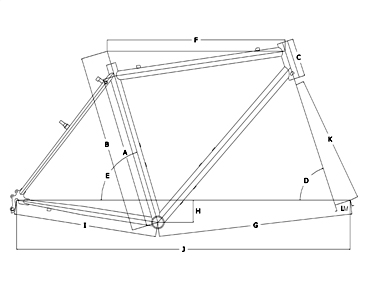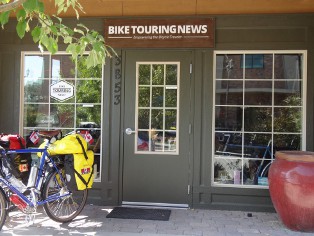So by now if you’ve read through all my meanderings on the subject (starting here) you’re probably wondering how I’m going to put it all together into one scientific, absolute method that will tell you exactly what size touring bike to buy. Me too. I’m not sure their is a magic formula for knowing which size bike from any given maker will fit you best. But, hopefully with the information in these pages the uninitiated or the plain old confused bike rider will have tools to help them cut through the miasma of conflicting advice and opinions and old wife’s tales proliferating on the ethernet, in bike shops and at cocktail parties.
GLOSSARY
Standover height- The distance from the floor to the top of the bicycle top tube, midway between the handlebars and the seat post.
Top tube- The horizontal-ish section of a bicycle frame spanning from the head tube, where the handlebar stem attaches, to the seat post or seat tube.
Actual top tube- Length of the top tube measured in line with the top tube from the center of the head tube to the center of the seat tube.
Virtual top tube- Used when the actual top tube is not horizontal. Measured horizontally (assuming bike is on a level surface) from the center of the head tube to the center of the extended seat tube, or the seat post.
Seat tube- The vertical-ish component of a bicycle frame, which extends from the bottom bracket shell, where the crank is connected, to where the seat post is inserted.
Seat post- Tube with a clamp on one end to attach to the saddle rails. The other end inserts into the seat tube.
Saddle rails- The tubular metal frame on the underside of the bicycle saddle. The two rails are clamped onto the seat post.
Stem- Bicycle component one end of which clamps onto, or is inserted into, the fork with the opposite end clamping the handlebars.
Saddle height- Measurement taken in line with the seat tube from the center of the crank or bottom bracket to the top surface of the saddle.
Saddle set back- The horizontal distance between the widest part of the saddle and the bottom bracket.
Frame size- A measurement of the length of the seat tube from the center of the bottom bracket to either the top or center of the top tube.
Let’s start with some assumptions and goals. People reading this will either be in the market for a new to them bike or else they already have a bike they want to use for touring. For our purposes we will assume they will be carrying some sort of load. It may be a light load for an overnight trip or the bike might be loaded down with enough gear and food and water to go for several days. More than speed or aerodynamics, comfort and efficiency over several hours per day will be the main goal. We will not be racing and are not overly concerned about the weight of the bike. Everyone who has read this far in this section and has read this post and this post will know when they are being bull-shitted. You know what features are going to be important for the intended use of the bicycle. If the bike you are looking at doesn’t have those features…..keep looking.
And now for the $64,000 question…how does one know what size? First you need to know the geometry of the particular model. This can almost always be found on the manufacturer’s website, and will probably include a diagram like this.
You should be able to locate the dimensions for the virtual top tube (F) and the seat tube (A) and maybe for the virtual seat tube (B). On a bike with a sloping top tube such as this one there will be no standard correlation with the seat tube length and the top tube length (virtual or actual), but the top tube will usually be longer than the seat tube, and that makes it tough to pick a size based only on the stated size of the frame. On a bike with a level, or slightly up-sloping, top tube there will be a correlation and the top tube length will be within a couple centimeters of the seat tube length. Got me?
Back when almost every road bike had a level top tube, the Swiss engineer Wilfried Huggi figured that the product of one’s inseam multiplied by .65 was the right number for frame size. This was based on tests done with a large number of riders. Keep in mind, at that time a 55 cm bike probably had a top tube that measured within one centimeter of 55. Greg Lemond espouses this method in his book “Greg LeMond’s Complete Book of Cycling” but he was also convinced that the smallest possible frame was optimal for racing. As a tourist you don’t want the smallest possible frame. And since there is no longer necessarily a correlation between nominal frame size and top tube length, top tube length becomes more important than the stated size of a bike.
I’m going to go way out on a limb here and say that inseam multiplied by .66 to .67 will give a range of top tube lengths that will work for most people. My inseam is 88 cm and I ride a Rivendell with a 59 cm top tube (88X.67) and I ride a Surly with a 58 cm top tube (88X.66). Both bikes are super comfortable and the difference in top tube length can be mitigated by the length of the stem and by the relative handlebar height. Sky King rides a Rivendell with a 54 cm top tube and her inseam is 82cm (82 X .66 =54.12)
Since none of these parameters are cast in stone the ideal scenario would be to saunter down to the local touring bike shop and test ride a couple of bikes that fall within the size range you have just ascertained. You will already know the correct saddle height because you have read this and you will know your inseam measurement. So ask the person who is helping you to set the saddle to the correct height.
Now, does the bike look right? Is it easy to set the height of the handlebars so that they are close to the same level as the saddle, without the need to add any extensions or resort to crazy looking fixes? On a bike with an adequate top tube length, if the bars are significantly lower than the saddle after you have set the saddle height then the bike is probably not designed for touring, but is more of a sport or racing bike. Don’t buy it. Otherwise, take it out for a spin and see how it feels. Ideally they will have a couple sizes available so you can compare and contrast. Remember, you know what you are looking for and what your plans are for the bike, and you know how it feels when you ride it, so don’t let the sales person talk you into something that doesn’t impress you as workable. By and large, most bike shop employees don’t know touring or touring bikes, and they will try to steer you to a bike that will end up being too small.
Odds are, you won’t be able to test ride the specific size you want to, again because touring bikes are off the radar for most bike shops. All of the mid to high end makers of touring bikes such as Rivendell and Bruce Gordon will have detailed sizing instructions on their websites and are happy to help over the phone too. Production makers like Surly may not have such clear direction, but I know from my years of experience selling Surly bikes that the outline I have given in these pages will serve you well in picking a bike that will work for touring. Once you have a bike that is the right size you can work out all the specific details like saddle set back as well as handlebar height and stem length to affect the final overall reach.


Recent Comments